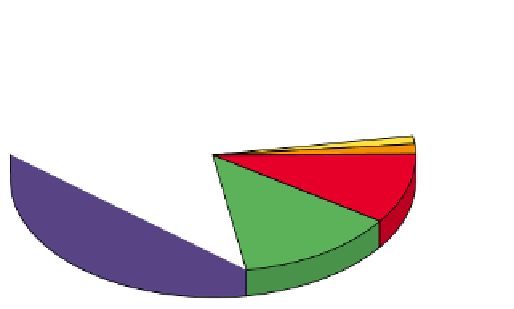Environmental Engineering Reference
In-Depth Information
■
About 2.5 million nonreturnable plastic bottles
every hour.
■
About 670,000 metric tons (1.5 billion pounds) of
edible food per year.
■
Enough office paper each year to build a wall
3.5 meters (11 feet) high across the country from New
York City to San Francisco, California.
■
Some 186 billion pieces of junk mail (an average of
660 pieces per American) each year, about 45% of
which are thrown in the trash unopened.
Critical thinking: what contribution do you make in the
United States or in the country where you live to each of
these items?
Sewage sludge
1%
Municipal
1.5%
Mining and oil
and gas
production
75%
Industry
9.5%
Agriculture
13%
Figure 17-2
Natural capital waste and degradation:
sources
of the estimated 11 billion metric tons (12 billion tons) of solid
waste produced each year in the United States. Mining, oil and
gas production, agricultural, and industrial activities produce
65 times as much solid waste as household activities. (Data
from U.S. Environmental Protection Agency and U.S. Bureau
of Mines)
17-2
PRODUCING LESS WASTE
Solutions: Waste Management
and Waste Reduction
We can try to manage the solid wastes we produce or
try to reduce or prevent their production.
We can deal with the solid wastes we create in two
ways: waste management or waste reduction.
Waste management
is a
high-waste approach
(Fig-
ure 2-12, p. 33) that views waste production as a
mostly unavoidable product of economic growth. It at-
tempts to manage the wastes that result from eco-
nomic growth in ways that reduce environmental
harm, mostly by mixing and often crushing wastes
together and then burying them, burning them, or
shipping them to another state or country. In effect, it
commingles wastes and then transfers them from one
part of the environment to another.
In contrast,
waste reduction
is a
low-waste approach
that recognizes there is no “away.” It mimics nature by
viewing most solid wastes as potential resources that
we should be reusing, recycling, or composting (Fig-
ure 2-13, p. 33). With this approach, we should think of
trashcans and garbage trucks as
resource containers.
Figure 17-3 lists ways to reduce waste. Waste re-
duction is the preferred solution because it tackles the
problem of waste production at the front end—before
it occurs—rather than at the back end—after wastes
have already been produced. It also saves matter and
energy resources, reduces pollution (including emis-
sions of greenhouse gases), helps protect biodiversity,
and saves money.
Currently, the priorities for dealing with solid
waste in the United States and in most countries are the
reverse of the order suggested by prominent scientists
in Figure 17-3. It does not have to be that way. Some sci-
entists and economists estimate that 60-80% of the solid
waste we produce can be eliminated by a combination
of
reducing waste production, reusing and recycling materi-
als
(including composting), and
redesigning
manufac-
turing processes and buildings to produce less waste.
Canada is the world's second-largest per capita
producer of MSW. Japan and most developed countries
in Europe produce about half as much MSW per per-
son as the United States, and most developing coun-
tries produce about one-fourth to one-tenth as much.
According to the U.S. Environmental Protection
Agency (EPA), 55% of the MSW produced in the United
States is dumped in landfills, 30% is recycled or com-
posted, and 15% is burned in incinerators. Paper makes
up about 38% of the trash buried in U.S. landfills, fol-
lowed by yard waste (12%), food waste (11%), and plas-
tics (10%).
Case Study: Living in a High-Waste Society
Most solid waste is a highly visible sign of how a
society infected with affluenza wastes valuable
resources.
Consider a few of the solid wastes that U.S. consumers
throw away in their high-waste economy:
■
Enough aluminum to rebuild the country's entire
commercial airline fleet every 3 months.
■
Enough tires each year to encircle the planet al-
most three times.
■
Enough disposable diapers per year that if they
were linked end to end, they would reach to the moon
and back seven times.
■
About 130 million cell phones, 50 million comput-
ers, and 8 million television sets each year. This
elec-
tronic waste
or
e-waste,
the fastest-growing solid waste
problem in the United States and the world. It is also a
source of toxic and hazardous wastes including lead,
mercury, and cadmium that can contaminate the air,
surface water, groundwater, and soil.
■
Enough carpet each year to cover the state of
Delaware.







